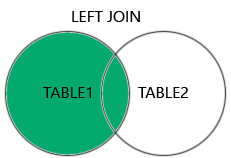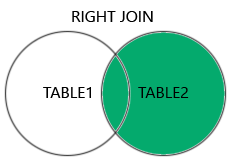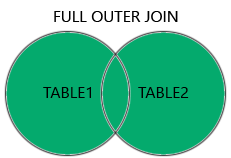There are ways to work with multiple tables in the same query, we can use:
- Sub-queries
- Implicit Join
- Join operators (INNER, OUTER…)
Joins
This section will cover methods to join or cbind (if you’re familiar with R) - What’s important to remember is that
UNIONwillrbind, in other words it’ll merge vertically, it’ll add rows that pass the criteria vertically, so we end up with the same width object but the length will vary.JOINwillcbind. It will merge horizontally, so the column number will change (in most cases)
A
JOINclause is used to combine rows from two or more tables, based on a related column between them.
We’ll use this setup for examples:
- dataset: SouthWind_database
- left table: Orders
- right table: Customers
- related column: CustomerID
Orders Table
| OrderID | CustomerID | OrderDate |
|---|---|---|
| 10308 | 2 | 1996-09-18 |
| 10309 | 37 | 1996-09-19 |
| 10310 | 77 | 1996-09-20 |
Customers Table
| CustomerID | CustomerName | ContactName | Country |
|---|---|---|---|
| 1 | Alfreds Futterkiste | Maria Anders | Germany |
| 2 | Ana Trujillo Emparedados y helados | Ana Trujillo | Mexico |
| 3 | Antonio Moreno Taquería | Antonio Moreno | Mexico |
| ShipperID | ShipperName | Phone |
|---|---|---|
| 1 | Speedy Express | (503) 555-9831 |
| 2 | United Package | (503) 555-3199 |
| 3 | Federal Shipping | (503) 555-9931 |
Inner Join
Syntax:
SELECT column_name(s)
FROM table1
INNER JOIN table2
ON table1.column_name = table2.column_name;Example with Aliases
SELECT B.Borrower_ID, B.Last_name, B.Country, L.Borr_ID, L.Loan_ID
FROM BORROWER B
INNER JOIN LOAN L
ON B.Borrower_ID = L.Borr_ID(INNER) JOIN&JOINBoth accomplish the same and return records that have matching values in both tables- It is very likely that some customers will have multiple orders in the Orders table
- If you have multiple columns in each table that share the same name with columns in the other table(s) it’s best to include each Tables name in the command

- We want ALL ORDERS from customers from Customers table that had an order in the Orders table, use CustomerID as the common column
SELECT Orders.OrderID, Customers.CustomerName, Orders.OrderDate
FROM Orders
INNER JOIN Customers
ON Orders.CustomerID = Customers.CustomerID;Output:
Number of Records: 196
| OrderID | CustomerName | OrderDate |
|---|---|---|
| 10308 | Ana Trujillo Emparedados y helados | 9/18/1996 |
| 10365 | Antonio Moreno Taquería | 11/27/1996 |
| 10383 | Around the Horn | 12/16/1996 |
| 10355 | Around the Horn | 11/15/1996 |
| 10278 | Berglunds snabbköp | 8/12/1996 |
| 10280 | Berglunds snabbköp | 8/14/1996 |
multiple tables
- What if we want to select all Orders with Customers and Shippers information?
- It means we have to
JOINthree tables - We already
INNER JOINtwo tables above now all we do is join that joint with anotherINNER JOINcommand - Note: the first 4 lines are the same as the code chunk above EXCEPT the FROM is now a list, hence the ( )
SELECT Orders.OrderID, Customers.CustomerName, Orders.OrderDate
FROM (( Orders
INNER JOIN Customers
ON Orders.CustomerID = Customers.CustomerID)
INNER JOIN Shippers
ON Orders.ShipperID = Shippers.ShipperID);Output:
Number of Records: 196
| OrderID | CustomerName | ShipperName |
|---|---|---|
| 10290 | Comércio Mineiro | Speedy Express |
| 10284 | Lehmanns Marktstand | Speedy Express |
| 10388 | Seven Seas Imports | Speedy Express |
| 10390 | Ernst Handel | Speedy Express |
Left Join
- Syntax:
SELECT column_name(s)
FROM table1
LEFT JOIN table2
ON table1.column_name = table2.column_name;LEFT (OUTER) JOIN: Returns all records from the left table, and the matched records from the right table- Regardless of any matches with the right table, it will return at least ALL records from the left table

Example:
SELECT Customers.CustomerName, Orders.OrderID
FROM Customers
LEFT JOIN Orders
ON Customers.CustomerID=Orders.CustomerID
ORDER BY (if any);Right Join
- Syntax
SELECT column_name(s)
FROM table1
RIGHT JOIN table2
ON table1.column_name = table2.column_name;RIGHT (OUTER) JOIN: Returns all records from the right table, and the matched records from the left table- Regardless of any matches with the left table, it will return at least ALL records from the right table

Full Join
- Syntax:
SELECT column_name(s)
FROM table1
FULL OUTER JOIN table2
ON table1.column_name = table2.column_name
WHERE condition (if any);FULL (OUTER) JOIN: Returns all records when there is a match in either left or right tableFULL OUTER JOIN&FULL JOINare the same- Note: The
FULL OUTER JOINreturns all matching records from both tables whether the other table matches or not. So, if there are rows in table1 that do not have matches in table2, or if there are rows in table2 that do not have matches in table1, those rows will be listed as well. - Be aware that this type of join might return a very large result

Example:
SELECT Customers.CustomerName, Orders.OrderID
FROM Customers
FULL OUTER JOIN Orders
ON Customers.CustomerID = Orders.CustomerID
ORDER BY Customers.CustomerName;Output:
| CustomerName | OrderID |
|---|---|
| Null | 10309 |
| Null | 10310 |
| Alfreds Futterkiste | Null |
| Ana Trujillo Emparedados y helados | 10308 |
| Antonio Moreno Taquería | Null |
Self Join
- Syntax:
SELECT column_name(s)
FROM table1 T1, table1 T2
WHERE condition;- Self Join is a regular join but the table is joined with itself
- In the code above, T1 and T2 are aliases of the same table
Customers table:
| CustomerID | CustomerName | ContactName | Address | City | PostalCode | Country |
|---|---|---|---|---|---|---|
| 1 |
Alfreds Futterkiste | Maria Anders | Obere Str. 57 | Berlin | 12209 | Germany |
| 2 | Ana Trujillo Emparedados y helados | Ana Trujillo | Avda. de la Constitución 2222 | México D.F. | 05021 | Mexico |
| 3 | Antonio Moreno Taquería | Antonio Moreno | Mataderos 2312 | México D.F. | 05023 | Mexico |
Example:
- Let’s extract all unique customers that are from the same city
- So, using the same table we’d set a condition that CustomerID are not equal -> unique
- We’d set the City to be equal -> we want all unique customers from they city being the same
- To pull their names we
SELECT Customer Nameas well
SELECT A.CustomerName AS CustomerName1, B.CustomerName AS CustomerName2, A.City
FROM Customers A, Customers B
WHERE A.CustomerID <> B.CustomerID
AND A.City = B.City
ORDER BY A.City;Output:
| CustomerName1 | CustomerName2 | City |
|---|---|---|
| FISSA Fabrica Inter. Salchichas S.A. | Bólido Comidas preparadas | Madrid |
| Bólido Comidas preparadas | FISSA Fabrica Inter. Salchichas S.A. | Madrid |
| Bólido Comidas preparadas | Romero y tomillo | Madrid |
| FISSA Fabrica Inter. Salchichas S.A. | Romero y tomillo | Madrid |
| Ana Trujillo Emparedados y helados | Antonio Moreno Taquería | México D.F. |
| Pericles Comidas clásicas | Centro comercial Moctezuma | México D.F. |
| Antonio Moreno Taquería | Centro comercial Moctezuma | México D.F. |
| Antonio Moreno Taquería | Tortuga Restaurante | México D.F. |
| Centro comercial Moctezuma | Tortuga Restaurante | México D.F. |
Implicit Joins
This section crosses between subquery and joins, it is more a join than a subquery so I’ll include it here as well as in the subquery page.
2 Tables in From
- Consider what would happen if we used 2 tables in the From statement
- This will result in a FULL JOIN - Cartesian Join
- You will end up with more rows than for each table individually
Every row from the first table is joined with every row from the second table, no common keys/columns are used, so you can imagine how big can become if we have two large tables
SELECT *
FROM Employees, Departments
Filter
Lets limit the results of the join using additional operands. We want the rows where dept_id matches dep_id. Note the use of table names to prefix with every column name
SELECT *
FROM Employees, Departments
WHERE Employees.dep_id = Departments.dept_id;Alias
Since table names can be long and our statements can become long and complicated, we can use aliases without the use of AS
SELECT *
FROM Employees E, Departments D
WHERE E.dep_id = D.dept_id;
# __ To subset even further we can narrow the SELECT statement
SELECT Emp_id, Dep_name
FROM Employees E, Departments D
WHERE E.dep_id = D.dept_id;Summary
Implicit Inner Join |
SELECT column_name(s) FROM table1, table2 WHERE table1.column_name = table2.column_name; |
Implicit Inner Join combines two or more records but displays only matching values in both tables. Inner join applies only the specified columns. |
SELECT * FROM employees, jobs where employees.job_id = jobs.job_ident; |
| Implicit Cross Join | SELECT column_name(s) FROM table1, table2; |
Implicit Cross Join is defined as a Cartesian product where the number of rows in the first table is multiplied by the number of rows in the second table. |
SELECT * FROM employees, jobs; |
| Topic | Syntax | Description | Example |
|---|
| Cross Join | SELECT column_name(s) FROM table1 CROSS JOIN table2; |
The CROSS JOIN is used to generate a paired combination of each row of the first table with each row of the second table. |
SELECT DEPT_ID_DEP, LOCT_ID FROM DEPARTMENTS CROSS JOIN LOCATIONS; |
| Inner Join | SELECT column_name(s) FROM table1 INNER JOIN table2 ON table1.column_name = table2.column_name; WHERE condition; |
You can use an inner join in a SELECT statement to retrieve only the rows that satisfy the join conditions on every specified table. |
select E.F_NAME,E.L_NAME, JH.START_DATE from EMPLOYEES as E INNER JOIN JOB_HISTORY as JH on E.EMP_ID=JH.EMPL_ID where E.DEP_ID ='5'; |
| Left Outer Join | SELECT column_name(s) FROM table1 LEFT OUTER JOIN table2 ON table1.column_name = table2.column_name WHERE condition; |
The LEFT OUTER JOIN will return all records from the left side table and the matching records from the right table. |
select E.EMP_ID,E.L_NAME,E.DEP_ID,D.DEP_NAME from EMPLOYEES AS E LEFT OUTER JOIN DEPARTMENTS AS D ON E.DEP_ID=D.DEPT_ID_DEP; |
| Right Outer Join | SELECT column_name(s) FROM table1 RIGHT OUTER JOIN table2 ON table1.column_name = table2.column_name WHERE condition; |
The RIGHT OUTER JOIN returns all records from the right table, and the matching records from the left table. |
select E.EMP_ID,E.L_NAME,E.DEP_ID,D.DEP_NAME from EMPLOYEES AS E RIGHT OUTER JOIN DEPARTMENTS AS D ON E.DEP_ID=D.DEPT_ID_DEP; |
| Full Outer Join | SELECT column_name(s) FROM table1 FULL OUTER JOIN table2 ON table1.column_name = table2.column_name WHERE condition; |
The FULL OUTER JOIN clause results in the inclusion of rows from two tables. If a value is missing when rows are joined, that value is null in the result table. |
select E.F_NAME,E.L_NAME,D.DEP_NAME from EMPLOYEES AS E FULL OUTER JOIN DEPARTMENTS AS D ON E.DEP_ID=D.DEPT_ID_DEP; |
| Self Join | SELECT column_name(s) FROM table1 T1, table1 T2 WHERE condition; |
A self join is regular join but it can be used to joined with itself. |
SELECT B.* FROM EMPLOYEES A JOIN EMPLOYEES B ON A.MANAGER_ID = B.MANAGER_ID WHERE A.EMP_ID = 'E1001'; |
Joins in MySQL using phpMyAdmin
| Full Outer Join |
|
The UNION operator is used to combine the result-set of two or more SELECT statements. |
|